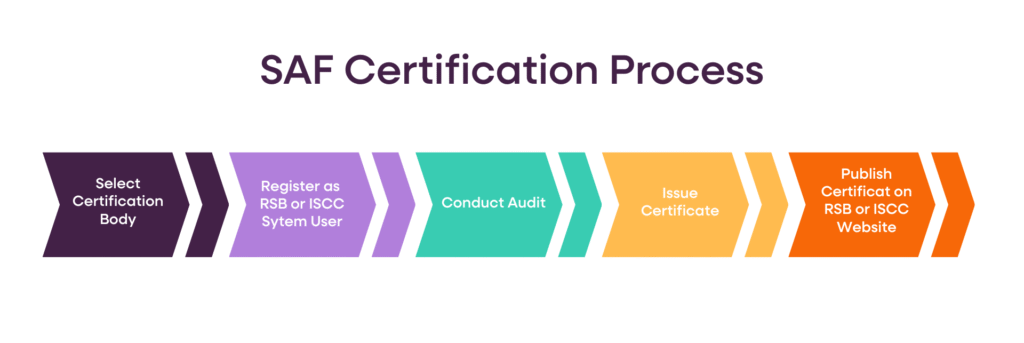SAF 101: Certification
Sustainability certification is a way to ensure products, services, and organizations are operating in line with established environmental, social, and economic criteria or standards. For sustainable aviation fuel (SAF), certification exists to ensure that the fuel achieves reductions in life-cycle greenhouse gas (GHG) emissions and that the production processes don’t contribute to issues like deforestation, food supply shortages, or ecological disruption. Specifically, the SAF certification process focuses on:
- Verifying life-cycle emissions reductions
- Assessment and mitigation of risk throughout the entire supply chain
- Sustainability of feedstock production
- Tracing materials through the supply chain
Certification is conducted at least once a year and involves all organizations along the SAF supply chain that modify or take possession of the SAF or its components in some way. This includes feedstock suppliers, SAF producers, and companies that distribute SAF to the end customer. Let’s take a closer look at how it works.
The Players
Before getting into the details of the certification process, it’s helpful to understand the various entities that have a stake in the certification process:
- Regulatory bodies: Organizations that create the standards and framework required for certification
- Supply-chain operators: Companies seeking or covered within the sustainability certification. These companies are part of the fuel production and supply chain, such as feedstock suppliers, fuel manufacturers, and fuel suppliers
- Certification bodies: Entities that evaluate the compliance of supply-chain operators with the established standards and issue certifications to those in compliance
Establishing Sustainability Standards
The certification process begins with establishing the standards and frameworks that must be met for certification. There are a number of regulatory frameworks for sustainable aviation fuel, but the two most rigorous are CORSIA and EU RED.
The International Civil Aviation Organization (ICAO), a specialized agency of the United Nations, established the Carbon Offsetting Reduction Scheme for International Aviation (CORSIA) in 2016. CORSIA is a market-based measure created to provide a unified approach to reducing emissions from international aviation. Under the ICAO CORSIA framework, sustainability certification standards and criteria are called “sustainability certification schemes,” or SCS.
RED, which stands for Renewable Energy Directive, is a European legal framework that promotes the use of renewable energy. RED sets targets and standards in various sectors, including for the use of SAF in aviation. Under EU RED, certification standards are referred to as “voluntary schemes.”
The Process
The certification process has five basic steps, as outlined in the diagram below. In the first step, the company seeking certification chooses which certification it would like to obtain. After that, the chosen certification body will conduct an audit.
Currently, ICAO recognizes three sustainability certification systems that apply to SAF: the Roundtable on Sustainable Biomaterials (RSB), the International Sustainability & Carbon Certification (ISCC), and, most recently, ClassNK SCS, Nippon Kaiji Kyokai. However, ISCC and RSB are the two main certification schemes used to assess whether a company’s materials, products, or services comply with the standards. These two systems are very similar but have some differences in their focus.

ISCC primarily focuses on chain of custody traceability and ensuring that biofuels are produced from sustainable feedstocks, with an emphasis on compliance with CORSIA standards and EU RED. ISCC has established six principles for economic operators to follow as part of obtaining certification. They cover protection of land and biodiversity, air and water, and human rights.
RSB generally holds a broader sustainability assessment, encompassing environmental, social, and economic aspects across the entire supply chain. The RSB framework evaluates factors including risk assessment and mitigation, fuel sourcing and production, production and conversion processes, and end-of-life management. The main framework is underpinned by a comprehensive set of 12 principles and criteria that cover a broad range of sustainability issues including land use, continuous improvement planning, greenhouse gas emissions, and social development. If a company is concerned about how a product it uses is made, who is making it, and what materials are used, they can compare these concerns with a large set of sustainability practices ensured by RSB.
When it comes to SAF certification specifically, ISCC and RSB have one additional difference. RSB recognizes the environmental attributes associated with the physical SAF and has a specific program for the certification and management of the attributes, whereas ISCC does not. This means systems that involve Book & Claim — in which the environmental attributes of a sustainable fuel are decoupled from the physical fuel and sold as a separate product — are currently not recognized in the ISCC ecosystem. Therefore, there are no measures that an ISCC certifying body can use to audit what happens in a Book & Claim system.
Once the certification body completes its audit and determines that the company meets the established criteria, it will issue a “certificate of verification.” The certificate of verification proves that SAF has undergone a rigorous sustainability assessment and meets the necessary standards. This enables the certified company to provide proof of sustainability (PoS) documentation for its products or materials. The entire process is designed to build trust and transparency in the SAF supply chain and to ensure accountability and compliance at each step in the life cycle.
Why Certification Matters
Regardless of the certification body, SAF certification provides stakeholders with proof that the SAF they’re investing in is produced in a sustainable manner and reduces emissions at every stage of the value chain. It helps producers ensure they’re meeting the standards set by governments and international bodies, and it helps build credibility and trust in SAF as a viable solution for addressing the aviation industry’s growing demand for cleaner fuels, as well as its commitment to emissions reductions.
As SAF demand continues to grow, certification will remain an essential part of helping aviation along its path to net-zero emissions.



